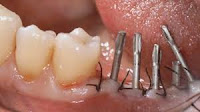One plane labial reduction of crown.. Over contoured
One plane labial reduction of crown:
a- Over contoured***
b- Occlusal disharmony
c- Increase retention.
Lip reduction is a term used to describe any operation that is intended to reduce the size and volume of the lip minora. The criteria for lip reduction are either functional or aesthetic, however in the majority of cases the latter is predominant. This is surprising since the ideal female vulva does not exist, rather a wide range of labial lengths and widths, as well as clitoral sizes.
What are the lips?
The minora of lips are the small folds of the thin and fragile skin which are on each side of the real vaginal introitus. They are about 6.4 cm in length, and about 2 cm 0.4 in the distance, on average. It is important to note that the actual range is much wider, with normal variants being anywhere from 1.2 cm to 10 cm in length and 0.7 cm to 5 cm wide. Interestingly, the two lips of the same woman are very often of different lengths. This proves that significant variations in labial size from one side to the other, as well as between different women, are perfectly normal and should never in any way be interpreted as hypertrophy or abnormal.
The clitoris is also between cm 0.2 to 3.5 long, and up to 1 cm wide. Contrary to popular thought, a larger clitoris is associated with greater pleasure and a higher possibility of noticing the sexual climax.
Lip hypertrophy:
The labial hypertrophy has been tried to be defined in terms of labial length. The category of Felicio classifies it by category in four:
- Type 1: Less than 2 cm
- Type - 2: 2-4 cm
- Type 3: 4-6 cm
- Type 4: More than 6 cm.
Others define labial hypertrophy as anything more than 4 or 5 cm and advocate rectification if desired, but recognize that most cases are congenital in origin, that implicitly means it is a normal variant. A minority of cases may have acquired the hypertrophy to which is probably due:
- Exposure to exogenous androgens in the infant duration
- Application of estrogen preparations leading to overgrowth of lips
- Stretching by manual means or by fixing weights as in some indigenous tribes in the interest of the cultural norms of beauty
- continual dermatitis
- Lymphedema vulvae
- Infiltration of bone marrow
- Stretching in pregnancy, which is always a questionable etiology.
Signs for lip reduction:
The guidelines for lip reduction are very vague, as mentioned above. It is obvious that most such surgery is done on the basis of a woman's dissatisfaction with her lips rather than the actual functional or surgical reason for the procedure. For this reason, some authors have attempted to define labial hypertrophy as an anatomical entity to justify this function.
Surgery for lip reduction should be recommended or supported only if there are continual symptoms due to labial irritation, abnormal odor or real difficulty in sexual penetration. These are so unusually due to labial hypertrophy for are unlikely. It has also been determined that modern society prefers women to have small lips resembling those of prepubertal girls.
Lip reduction is a term used to describe any operation that is intended to reduce the size and volume of the lip minora. The criteria for lip reduction are either functional or aesthetic, however in the majority of cases the latter is predominant. This is surprising since the ideal female vulva does not exist, rather a wide range of labial lengths and widths, as well as clitoral sizes.
What are the lips?
The minora of lips are the small folds of the thin and fragile skin which are on each side of the real vaginal introitus. They are about 6.4 cm in length, and about 2 cm 0.4 in the distance, on average. It is important to note that the actual range is much wider, with normal variants being anywhere from 1.2 cm to 10 cm in length and 0.7 cm to 5 cm wide. Interestingly, the two lips of the same woman are very often of different lengths. This proves that significant variations in labial size from one side to the other, as well as between different women, are perfectly normal and should never in any way be interpreted as hypertrophy or abnormal.
The clitoris is also between cm 0.2 to 3.5 long, and up to 1 cm wide. Contrary to popular thought, a larger clitoris is associated with greater pleasure and a higher possibility of noticing the sexual climax.
Lip hypertrophy:
The labial hypertrophy has been tried to be defined in terms of labial length. The category of Felicio classifies it by category in four:
- Type 1: Less than 2 cm
- Type - 2: 2-4 cm
- Type 3: 4-6 cm
- Type 4: More than 6 cm.
Others define labial hypertrophy as anything more than 4 or 5 cm and advocate rectification if desired, but recognize that most cases are congenital in origin, that implicitly means it is a normal variant. A minority of cases may have acquired the hypertrophy to which is probably due:
- Exposure to exogenous androgens in the infant duration
- Application of estrogen preparations leading to overgrowth of lips
- Stretching by manual means or by fixing weights as in some indigenous tribes in the interest of the cultural norms of beauty
- continual dermatitis
- Lymphedema vulvae
- Infiltration of bone marrow
- Stretching in pregnancy, which is always a questionable etiology.
Signs for lip reduction:
The guidelines for lip reduction are very vague, as mentioned above. It is obvious that most such surgery is done on the basis of a woman's dissatisfaction with her lips rather than the actual functional or surgical reason for the procedure. For this reason, some authors have attempted to define labial hypertrophy as an anatomical entity to justify this function.
Surgery for lip reduction should be recommended or supported only if there are continual symptoms due to labial irritation, abnormal odor or real difficulty in sexual penetration. These are so unusually due to labial hypertrophy for are unlikely. It has also been determined that modern society prefers women to have small lips resembling those of prepubertal girls.
procedures:
Many techniques have been designed to achieve lip reduction, which include:
De-epithelialization that removes some tissue from the lips but does not change the shape, and is thus suitable for thinning down the lips rather than garnish their length or width
Excision or direct lining that cut off the excess length, but is not ideal as it leaves a horizontal scar, causes rippling of the ridges, removes the natural shape and may leave the fibrous and firm lips
Key resection removes a V-shaped piece of skin with fundamental subcutaneous tissues to reduce labial volume but to preserve more skin. The incision first left a horizontal scar and an overhanging hood. The modified extended key incision is performed so as to leave an invisible scar in the crease between the lip majora and the minora. It leaves the edge intact and does not change the pigmentation.
Z-plasty is another modification that uses a z-shaped incision to further reduce the incidence of postoperative clamping or scarring.
Composite reduction is an even more central key resection that extends the transverse incision to adjust the shape of the clitoris as well by removing transverse clitoral tissue and decreasing the clitoral hood. However, it is also easier to screw up this rectification and she has a higher level of complications and revision surgery.
W-plasty and laser labiaplasty are among the most recent modifications of this surgery.
Whatever the technique, it should be clear to the patient that psychological problems likened to those of the fuselage dymorphic disorder can not be solved or even alleviated by having a medical professional to perform material alteration on his fuselage. Some experts were strongly of the opinion that professional consultation should be made available after explaining that the female genitalia do not fit the one size fits all approach, but there are almost as many variants as there are women in the world.
General or local anesthetic may be used, but the former is preferred. The skin is closed meticulously using the fine sutures in the layers to maximize the possibilities of healthy healing without a visible scar.
The procedure takes about a few hours at most, and most patients are put off by the next day. Postoperative care is important to optimize healing.
Postoperative care:
After a lip reduction procedure, the woman should keep the place dry and clean. He should also wear underwear and loose clothing, avoid friction between the injury and the overlying tissue, avoid sexual intercourse, and use sanitary fittings if needed during this time.
Complications:
A lip reduction surgery is usually calm, but complications occur in a limited number of patients, including dehiscence of injury, injury hematomas, chronic pain, ugly marking, and infection of the wound, as well as fin necrosis. Injuries to the neurovascular diet can hinder future sexual pleasure.
Low results may necessitate future revision surgery.
The patient satisfaction regimen with appearance is usually high, however, however long-term studies are not obtainable for improvement in sexual satisfaction following surgery.
Is lip reduction a form of female genital mutilation?
An interesting point of view has been raised for clarification by some researchers in forensic editions, namely: what is the difference between a cosmetic lip reduction surgery and a female genital mutilation, which is presently a criminal offense in developped countries ? It is proposed that the fact that the patient consents to lip reduction while the child who is largely the subject of female genital mutilation does not, is not a permissible difference between the two procedures. The largely cultural value attached to the desired appearance of the external genitalia would seem to be the motivating factor in both, and also be incorrect as a sign for the surgical procedure in both situations.






%20tube%20has%20stopped%20draining..%20Notify%20the%20physician.jpg)